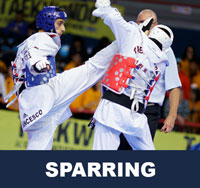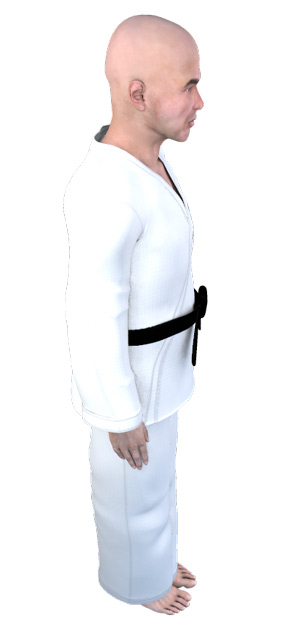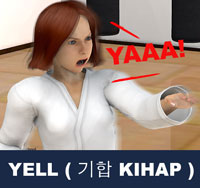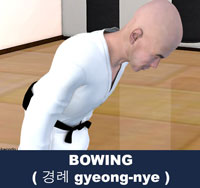Taekwondo 태권도Taekwondo Preschool
Promotion from one geup to the next can proceed rapidly in some schools, since schools often allow geup promotions every two, three, or four months. Students of geup rank learn the most basic techniques first, and then move on to more advanced techniques as they approach first dan. Many of the older and more traditional schools often take longer to allow students to test for higher ranks than newer, more contemporary schools, as they may not have the required testing intervals. View Taekwondo belt levels »
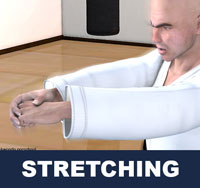
About Dynamic Stretching
Sports injuries are injuries that occur in athletic activities. They can result from acute trauma, or from overuse of a particular body part. Please see a certified specialist or doctor for sports injuries. Proper guidance and instructions are needed from a certified Master Instructor ( 사범님 sabeomnim ) to ensure safe training.
Dynamic stretching is a form of stretching beneficial in sports utilizing momentum from form, static-active stretching strength and the momentum from static-active stretching strength, in an effort to propel the muscle into an extended range of motion not exceeding one's static-passive stretching ability. Anything beyond this range of motion becomes ballistic stretching. It is a type of stretching while moving.
This form of stretching prepares the body for physical exertion and sports performance. In the past it was the practice to undertake static stretching before exercise. Dynamic stretching increases range of movement, blood and oxygen flow to soft tissues prior to exertion. Increasingly coaches and sports trainers are aware of the role in dynamic stretching in improving performance and reducing the risk of injury.
Benefits
Studies show that static stretches actually have a detrimental effect on explosive movements and strength output. There are two types of flexibility receptors: a static receptor, which measures magnitude and a dynamic receptor, which measures speed and magnitude. Dynamic activities that require movement, such as running, jumping or kicking use the dynamic receptor to limit flexibility. Therefore, a dynamic stretch that stresses the dynamic receptor is more beneficial when preparing for a warm-up when performing a dynamic activity. Dynamic stretching also includes constant motion throughout the warm-up, which maintains the core body temperature, whereas static stretching cage drop in temperature of several degrees. Another benefit of dynamic stretching is that it prepares the muscles and joints in a more specific manner since the body is going through motions it will likely repeat in the workout. It also helps the nervous system and motor ability since dynamic motions do more to develop those areas than static stretches. It is important to note that although many studies show the lack of benefit of static stretching before a workout, there is still much data to support the benefits of static stretching after a workout.
How to do Dynamic Stretching
Dynamic stretching works by the practitioner gently propelling their muscles towards their maximum range of motion. It is very important to note that the practitioner should not use jerky, forced movements to increase the range of motion beyond what is comfortable as it can easily cause injury. In general, the practitioner wants to move (stretch) the muscle in a similar way that they are going to move them in a workout. For example a martial arts practitioner who wants to stretch a hamstring for a kick may swing a straight leg forward to gradually increase the height they can obtain. Doing light kicks, with little explosive acceleration, while gradually increasing height, could also be considered a dynamic stretch.
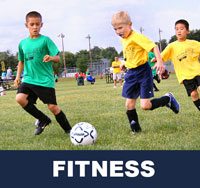
Related Articles
Physical fitness is a general state of health and well-being or specifically the ability to perform aspects of sports or occupations. It is a set of attributes or characteristics that people have or achieve that relates to the ability to perform physical activity. View Physical Fitness »
- Stretch - Form of physical exercise in which a specific muscle or tendon (or muscle group) is deliberately flexed or stretched in order to improve the muscle's felt elasticity and achieve comfortable muscle tone. The result is a feeling of increased muscle control, flexibility and range of motion.
- Flexibility - Refers to the absolute range of movement in a joint or series of joints, and length in muscles that cross the joints. Flexibility in some joints can be increased to a certain degree by exercise, with stretching a common exercise component to maintain or improve flexibility.
- Endurance - Ability of a practitioner to exert itself and remain active for a long period of time, as well as its ability to resist, withstand, recover from, and have immunity to trauma, wounds, or fatigue.
- Balance - Ability to maintain the line of gravity (vertical line from centre of mass) of a body within the base of support with minimal postural sway. Sway is the horizontal movement of the centre of gravity even when a person is standing still.
- Agility - Or nimbleness is the ability to change the body's position efficiently, and requires the integration of isolated movement skills using a combination of balance, coordination, speed, reflexes, strength, and endurance.
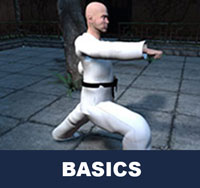
Taekwondo Basics
Here is where you can learn more about Taekwondo 태권도. Knowing the fundamental basics is very important for your learning path as you build your skills and knowledge. There are certain rules that need to be followed to show respect to the master ( 사범님 sabeomnim ), the instructors ( 교사님 gyosannim ), other practitioners and to the martial arts. They vary between schools but many have similar rules and guidelines. For more information View Taekwondo Basics »
Please follow the guidance of a certified Master Instructor or trainer when doing sports related activities. The article provided on this page is information that is widely available on Wikipedia articles "Stretching", "Static Stretching", "Dynamic Stretching", "Ballistic Stretching". Risk of injury can be reduced by completing an effective warm up consisting of a heart raiser to get your pulse up, followed by sport specific dynamic stretches (stretches whilst moving).
RESOURCES
This article uses material from the Wikipedia article "Dynamic Stretching", which is released under the Creative Commons Attribution-Share-Alike License 3.0.



